Free Version of Insode Out and Back Again
Android Versions
Android versions: A living history from 1.0 to thirteen
Explore Android's ongoing evolution with this visual timeline of versions, starting B.C. (Earlier Cupcake) and going all the way to 2022's still-nether-evolution Android 13 release.
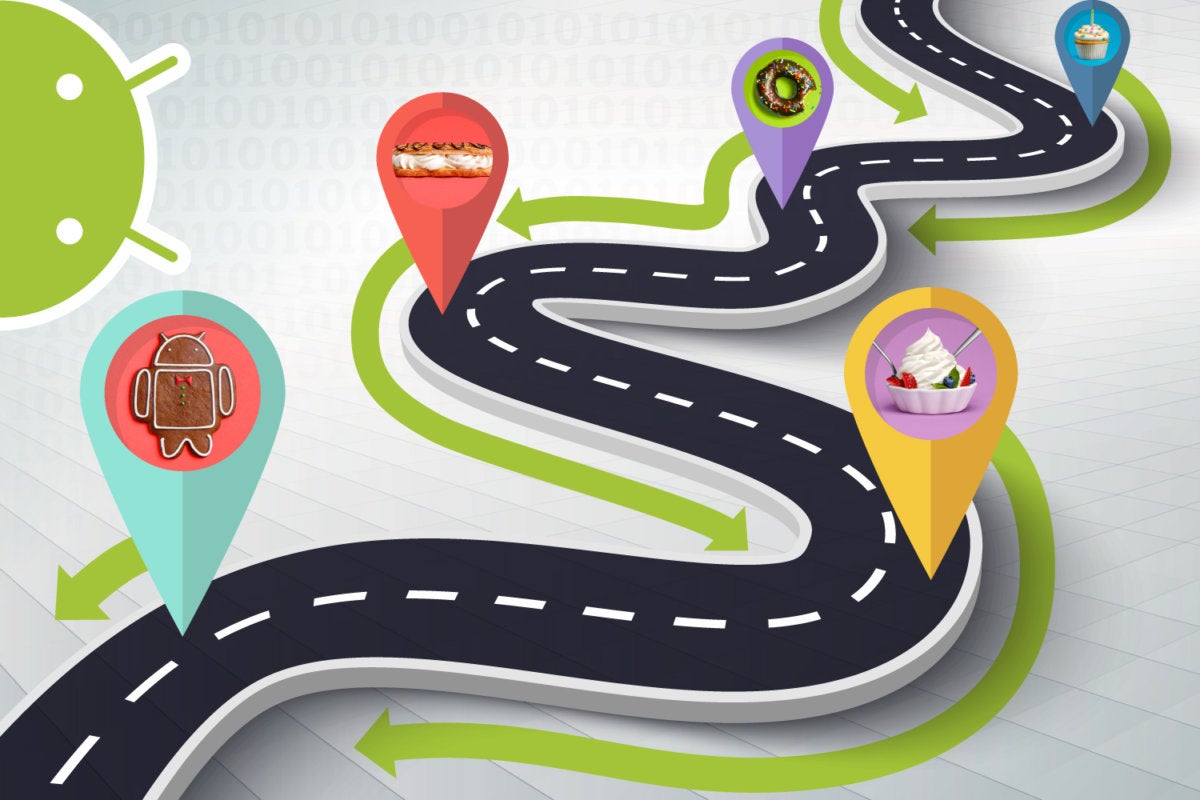
What a long, strange trip information technology's been.
From its inaugural release to today, Android has transformed visually, conceptually and functionally — time and fourth dimension again. Google'southward mobile operating arrangement may have started out scrappy, but holy moly, has it ever evolved.
Here'due south a fast-paced tour of Android version highlights from the platform's birth to nowadays. (Feel free to skip ahead if you just want to come across what's new in Android 12 or Android 13.)
Android versions one.0 to ane.1: The early on days
Android made its official public debut in 2008 with Android 1.0 — a release so ancient it didn't even accept a cute codename.
Things were pretty basic back then, but the software did include a suite of early Google apps like Gmail, Maps, Calendar, and YouTube, all of which were integrated into the operating system — a stark contrast to the more easily updatable standalone-app model employed today.
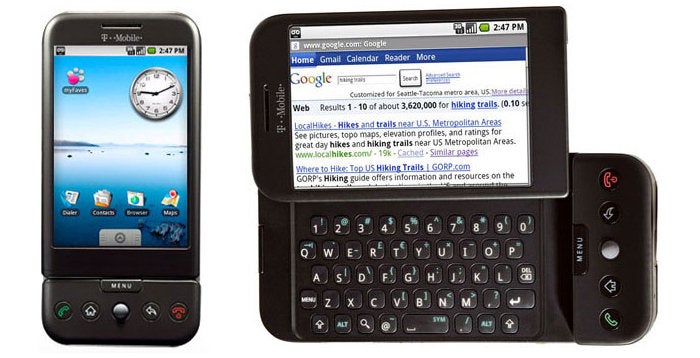 T-Mobile
T-Mobile The Android 1.0 home screen and its rudimentary web browser (non yet chosen Chrome).
Android version one.5: Cupcake
With early 2009'due south Android 1.5 Cupcake release, the tradition of Android version names was born. Cupcake introduced numerous refinements to the Android interface, including the first on-screen keyboard — something that'd exist necessary as phones moved away from the once-ubiquitous physical keyboard model.
Cupcake as well brought about the framework for tertiary-political party app widgets, which would quickly plow into one of Android's most distinguishing elements, and it provided the platform'south first-ever choice for video recording.
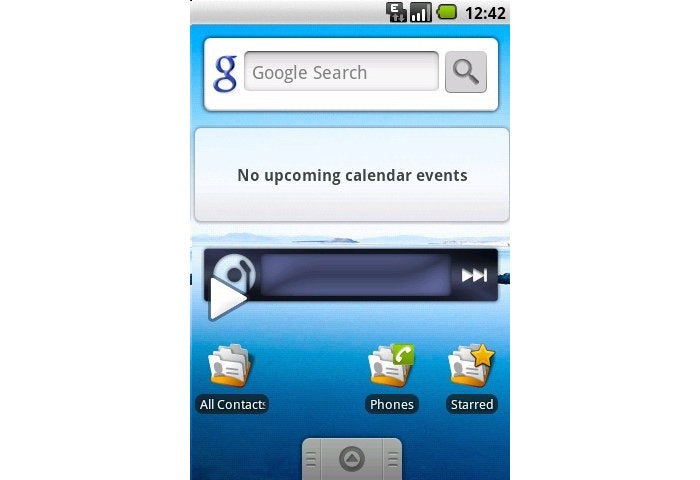 Android Police force (CC By-SA 4.0)
Android Police force (CC By-SA 4.0) Cupcake was all nearly the widgets.
Android version 1.half-dozen: Donut
Android one.half dozen, Donut, rolled into the globe in the autumn of 2009. Donut filled in some of import holes in Android'south centre, including the ability for the OS to operate on a diversity of different screen sizes and resolutions — a cistron that'd exist critical in the years to come up. It also added support for CDMA networks similar Verizon, which would play a key role in Android's imminent explosion.
 Google
Google Android'southward universal search box made its kickoff appearance in Android 1.6.
Android versions 2.0 to two.1: Eclair
Keeping upward the breakneck release pace of Android's early years, Android 2.0, Eclair, emerged just six weeks afterward Donut; its "point-ane" update, also called Eclair, came out a couple months later. Eclair was the showtime Android release to enter mainstream consciousness thanks to the original Motorola Droid phone and the massive Verizon-led marketing campaign surrounding it.
Verizon'southward "iDon't" ad for the Droid.
The release's most transformative element was the addition of vox-guided turn-by-turn navigation and existent-fourth dimension traffic info — something previously unheard of (and still substantially unmatched) in the smartphone earth. Navigation aside, Eclair brought live wallpapers to Android every bit well every bit the platform'southward first speech-to-text function. And information technology made waves for injecting the once-iOS-exclusive pinch-to-zoom capability into Android — a move frequently seen as the spark that ignited Apple tree's long-lasting "thermonuclear war" against Google.
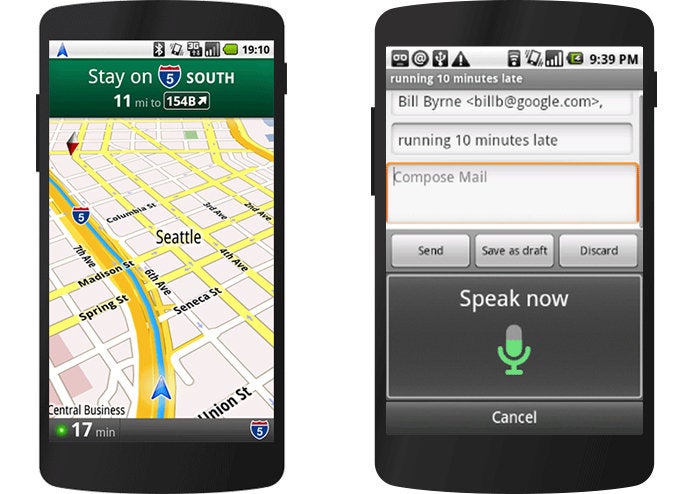 Google
Google The first versions of turn-by-turn navigation and speech communication-to-text, in Eclair.
Android version 2.2: Froyo
Simply 4 months later Android 2.ane arrived, Google served upwardly Android ii.two, Froyo, which revolved largely effectually under-the-hood functioning improvements.
Froyo did evangelize some important front-facing features, though, including the add-on of the at present-standard dock at the bottom of the home screen too as the starting time incarnation of Voice Actions, which allowed yous to perform bones functions like getting directions and making notes by tapping an icon and then speaking a command.
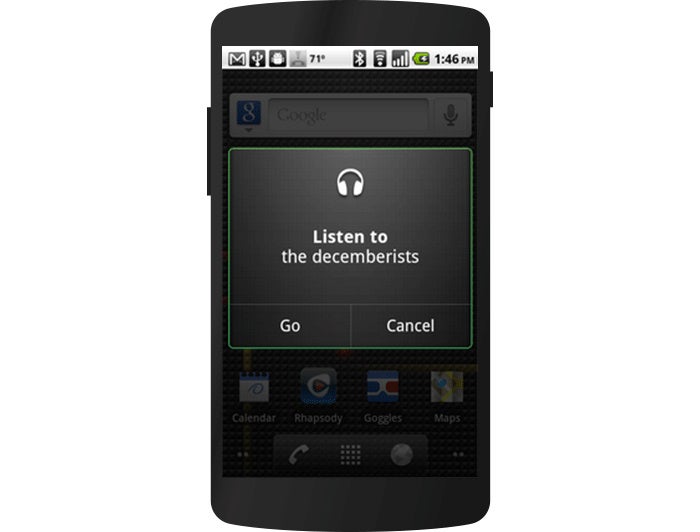 Google
Google Google'due south first real endeavour at vocalization control, in Froyo.
Notably, Froyo likewise brought support for Flash to Android'due south web browser — an option that was pregnant both considering of the widespread utilise of Flash at the time and because of Apple's adamant stance against supporting it on its own mobile devices. Apple would eventually win, of class, and Flash would become far less mutual. But back when information technology was still everywhere, being able to admission the full web without whatsoever black holes was a genuine advantage just Android could offering.
Android version 2.iii: Gingerbread
Android'due south starting time true visual identity started coming into focus with 2010's Gingerbread release. Bright green had long been the color of Android's robot mascot, and with Gingerbread, it became an integral role of the operating organisation's appearance. Black and dark-green seeped all over the UI as Android started its tedious march toward distinctive design.
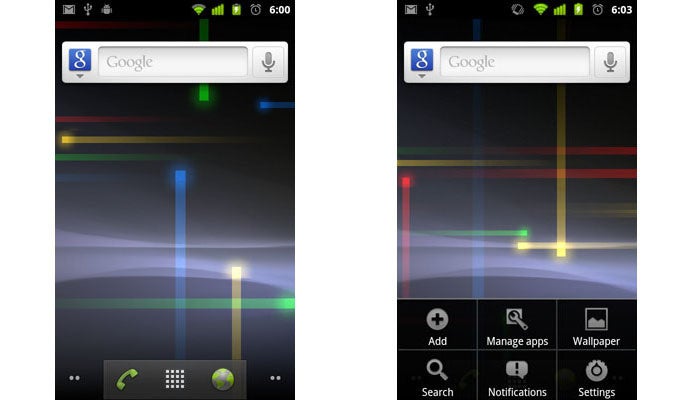 JR Raphael / IDG
JR Raphael / IDG It was easy being green back in the Gingerbread days.
Android 3.0 to 3.2: Honeycomb
2011'due south Honeycomb period was a weird time for Android. Android 3.0 came into the earth every bit a tablet-but release to accompany the launch of the Motorola Xoom, and through the subsequent 3.1 and three.2 updates, it remained a tablet-exclusive (and closed-source) entity.
Under the guidance of newly arrived design main Matias Duarte, Honeycomb introduced a dramatically reimagined UI for Android. It had a space-similar "holographic" pattern that traded the platform's trademark green for blue and placed an emphasis on making the most of a tablet's screen space.
 JR Raphael / IDG
JR Raphael / IDG Honeycomb: When Android got a case of the holographic blues.
While the concept of a tablet-specific interface didn't terminal long, many of Honeycomb's ideas laid the groundwork for the Android we know today. The software was the first to use on-screen buttons for Android'south principal navigational commands; information technology marked the beginning of the end for the permanent overflow-menu button; and information technology introduced the concept of a card-like UI with its take on the Recent Apps listing.
Android version 4.0: Ice Cream Sandwich
With Honeycomb acting as the bridge from old to new, Ice Cream Sandwich — also released in 2011 — served as the platform's official entry into the era of modern design. The release refined the visual concepts introduced with Honeycomb and reunited tablets and phones with a single, unified UI vision.
ICS dropped much of Honeycomb's "holographic" appearance but kept its utilise of blue as a organisation-wide highlight. And information technology carried over core organisation elements like on-screen buttons and a card-like appearance for app-switching.
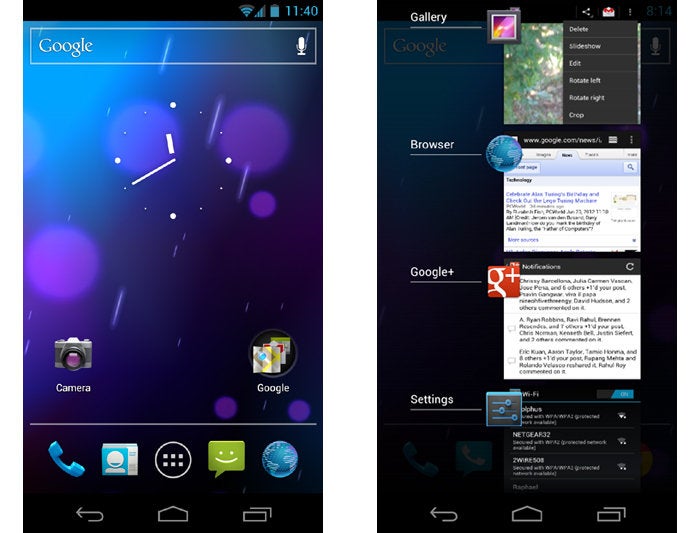 JR Raphael / IDG
JR Raphael / IDG The ICS abode screen and app-switching interface.
Android iv.0 also made swiping a more integral method of getting around the operating system, with the then-revolutionary-feeling ability to swipe away things like notifications and recent apps. And it started the slow procedure of bringing a standardized pattern framework — known equally "Holo" — all throughout the OS and into Android's app ecosystem.
Android versions 4.one to iv.three: Jelly Bean
Spread across three impactful Android versions, 2012 and 2013'due south Jelly Bean releases took ICS'south fresh foundation and made meaningful strides in fine-tuning and building upon it. The releases added plenty of poise and shine into the operating organization and went a long way in making Android more than inviting for the boilerplate user.
Visuals bated, Jelly Edible bean brought almost our outset gustation of Google At present — the spectacular predictive-intelligence utility that's sadly since devolved into a glorified news feed. It gave us expandable and interactive notifications, an expanded voice search organisation, and a more advanced organisation for displaying search results in general, with a focus on bill of fare-based results that attempted to answer questions directly.
Multiuser support also came into play, albeit on tablets only at this indicate, and an early version of Android'southward Quick Settings panel made its first appearance. Jelly Bean ushered in a heavily hyped system for placing widgets on your lock screen, too — 1 that, similar and then many Android features over the years, quietly disappeared a couple years later.
 JR Raphael / IDG
JR Raphael / IDG Jelly Edible bean's Quick Settings panel and brusk-lived lock screen widget feature.
Android version 4.4: KitKat
Late-2013'due south KitKat release marked the end of Android'southward dark era, equally the blacks of Gingerbread and the blues of Honeycomb finally made their manner out of the operating system. Lighter backgrounds and more neutral highlights took their places, with a transparent status bar and white icons giving the OS a more gimmicky appearance.
Android four.four also saw the outset version of "OK, Google" support — but in KitKat, the hands-free activation prompt worked only when your screen was already on and you were either at your home screen or inside the Google app.
The release was Google's starting time foray into challenge a full panel of the home screen for its services, too — at least, for users of its own Nexus phones and those who chose to download its first-ever standalone launcher.
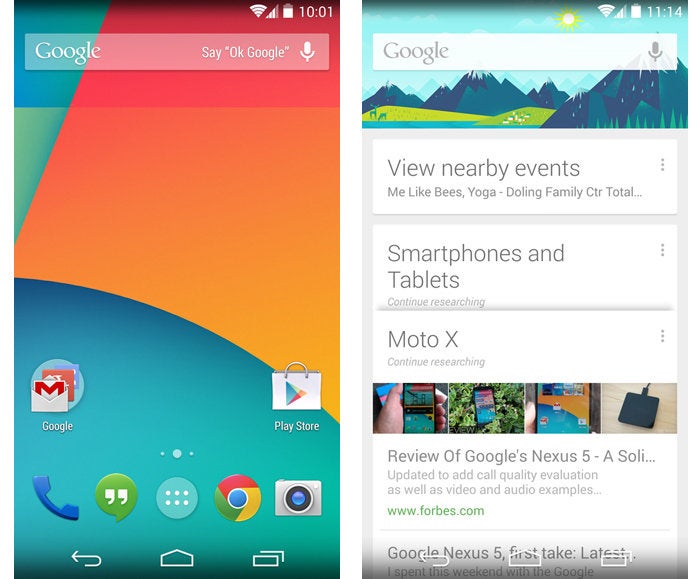 JR Raphael / IDG
JR Raphael / IDG The lightened KitKat home screen and its defended Google Now console.
Android versions five.0 and 5.1: Lollipop
Google essentially reinvented Android — again — with its Android 5.0 Lollipop release in the fall of 2014. Lollipop launched the withal-present-today Material Design standard, which brought a whole new expect that extended across all of Android, its apps and even other Google products.
The card-based concept that had been scattered throughout Android became a cadre UI pattern — i that would guide the appearance of everything from notifications, which at present showed upwardly on the lock screen for at-a-glance access, to the Recent Apps list, which took on an unabashedly card-based appearance.
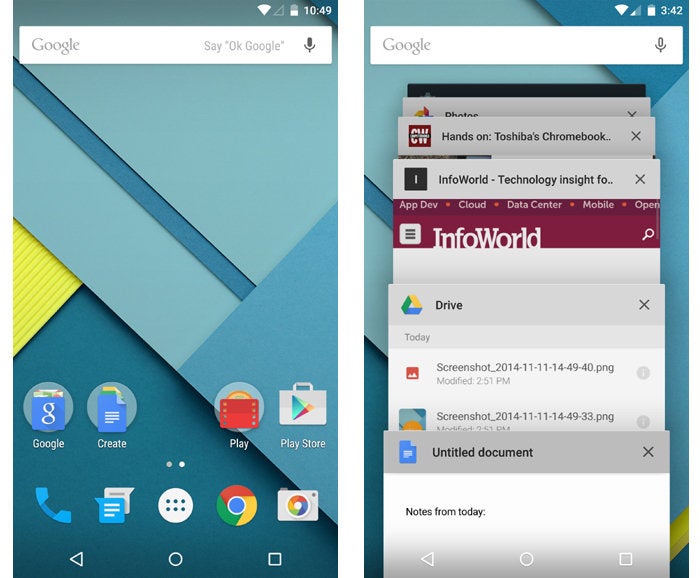 JR Raphael / IDG
JR Raphael / IDG Lollipop and the onset of Textile Blueprint.
Lollipop introduced a slew of new features into Android, including truly hands-free vocalism control via the "OK, Google" command, back up for multiple users on phones and a priority fashion for better notification management. It inverse and then much, unfortunately, that it besides introduced a bunch of troubling bugs, many of which wouldn't be fully ironed out until the post-obit year'south five.i release.
Source: https://www.computerworld.com/article/3235946/android-versions-a-living-history-from-1-0-to-today.html
0 Response to "Free Version of Insode Out and Back Again"
Post a Comment